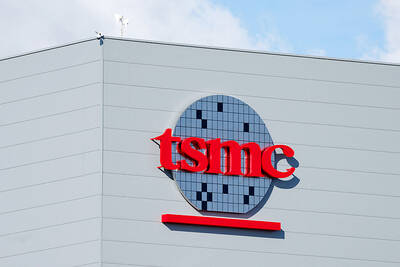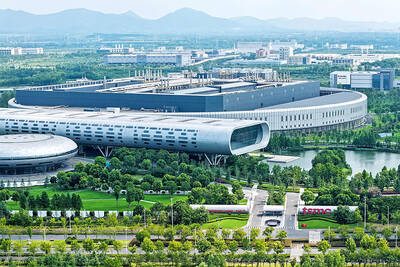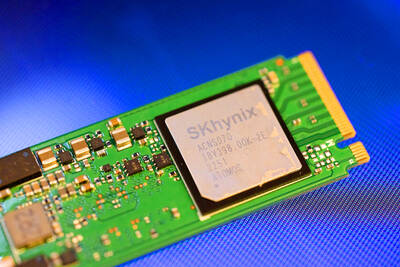Apple Inc’s suppliers are preparing to produce components for up to 75 million new iPhones in the second half of this year, roughly the same number as a year earlier, people familiar with the matter said.
The volumes planned for the next iPhone launch cycle would signal steady demand for the company’s most important product, despite US-China trade tensions and a decline in the overall smartphone market.
The company’s Asian suppliers are gearing up to produce components for three new iPhone models to meet holiday-season demand, said the people, who asked not to be identified citing internal estimates.
The US company’s Asian partners could ramp production up to 80 million new iPhones if needed, one of the people said.
Main iPhone assembler Hon Hai Precision Industry Co (鴻海精密) has stepped up hiring in Shenzhen, China, and is offering staff about 10 percent more than a year ago to secure a peak-period workforce, another person familiar with the matter said.
Apple has announced new iPhones each September since 2012 and the new models typically go on sale in the final weeks of that month.
Jeff Pu (蒲得宇) at GF Securities (Hong Kong) Brokerage Ltd (廣發證券香港) estimated that shipments of newly released iPhones would rise to 74 million in the second half, up about 7 percent from his estimate of 69 million last year, while TF International Securities Group Co (天風國際證券) analyst Kuo Ming-chi (郭明錤) forecast that Apple would sell 75 million to 80 million new iPhones in the second half of last year.
This year’s volumes might signal stabilization after a year of uncertainty, although that is a far cry from the double-digit growth numbers of years past.
Of course, that Apple suppliers plan to produce parts for 75 million new iPhones does not necessarily mean the company will sell that many.
Apple would assess sales after launch and the total shipments might not reach that mark.
The company declined to comment.
Apple is struggling with soft smartphone demand as people take longer to replace their gadgets and Chinese rivals like Huawei Technologies Co (華為) grab market share.
The US-China trade dispute is also denting Chinese economic growth while souring consumers there on US brands.
Analysts have been betting on a 13.3 percent drop in iPhone shipments to roughly 189 million in this fiscal year, average projections compiled by Bloomberg showed.
The major attraction in this year’s models lies in enhanced cameras: The two high-end models to replace the iPhone XS and iPhone XS Max are reportedly to include three back cameras, up from two, and a successor to the iPhone XR is to include a second back camera.
The third camera would serve as an additional ultra-wide lens, Bloomberg News reported in January, allowing the smartphone to automatically repair parts of an image that might be initially chopped out of a frame. It would also enable a wider range of zoom.
All three new models are also to include faster A13 processors built by Taiwan Semiconductor Manufacturing Co (台積電), Bloomberg News reported in May.

Taiwan Semiconductor Manufacturing Co (TSMC, 台積電) secured a record 70.2 percent share of the global foundry business in the second quarter, up from 67.6 percent the previous quarter, and continued widening its lead over second-placed Samsung Electronics Co, TrendForce Corp (集邦科技) said on Monday. TSMC posted US$30.24 billion in sales in the April-to-June period, up 18.5 percent from the previous quarter, driven by major smartphone customers entering their ramp-up cycle and robust demand for artificial intelligence chips, laptops and PCs, which boosted wafer shipments and average selling prices, TrendForce said in a report. Samsung’s sales also grew in the second quarter, up

On Tuesday, US President Donald Trump weighed in on a pressing national issue: The rebranding of a restaurant chain. Last week, Cracker Barrel, a Tennessee company whose nationwide locations lean heavily on a cozy, old-timey aesthetic — “rocking chairs on the porch, a warm fire in the hearth, peg games on the table” — announced it was updating its logo. Uncle Herschel, the man who once appeared next to the letters with a barrel, was gone. It sparked ire on the right, with Donald Trump Jr leading a charge against the rebranding: “WTF is wrong with Cracker Barrel?!” Later, Trump Sr weighed

LIMITED IMPACT: Investor confidence was likely sustained by its relatively small exposure to the Chinese market, as only less advanced chips are made in Nanjing Taiwan Semiconductor Manufacturing Co (TSMC, 台積電) saw its stock price close steady yesterday in a sign that the loss of the validated end user (VEU) status for its Nanjing, China, fab should have a mild impact on the world’s biggest contract chipmaker financially and technologically. Media reports about the waiver loss sent TSMC down 1.29 percent during the early trading session yesterday, but the stock soon regained strength and ended at NT$1,160, unchanged from Tuesday. Investors’ confidence in TSMC was likely built on its relatively small exposure to the Chinese market, as Chinese customers contributed about 9 percent to TSMC’s revenue last

LOOPHOLES: The move is to end a break that was aiding foreign producers without any similar benefit for US manufacturers, the US Department of Commerce said US President Donald Trump’s administration would make it harder for Samsung Electronics Co and SK Hynix Inc to ship critical equipment to their chipmaking operations in China, dealing a potential blow to the companies’ production in the world’s largest semiconductor market. The US Department of Commerce in a notice published on Friday said that it was revoking waivers for Samsung and SK Hynix to use US technologies in their Chinese operations. The companies had been operating in China under regulations that allow them to import chipmaking equipment without applying for a new license each time. The move would revise what is known